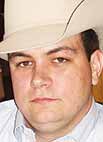
Value Added.
It is an overused term in business. When you sell what many others sell, what sets your product apart will be the “value added.”
“It’s not just about the idea that you have a few cows, you buy a bull, you breed them, you feed them a little and take them to the sale barn.”
Josh Worthington is the 27-year-old General Manager of the Missouri Angus Association. He works out of his home in Dadeville, Mo. But home is more likely a hotel room somewhere else in Missouri.
“I travel quite a bit. Thirty weekends, thru the week – doing herd visits. If there is an Angus sale in the state, I try to go.”
Josh started showing cattle as a teenager. This led to involvement in the FFA (he was the Missouri State FFA Association's president 1999-2000), then to college at Missouri State University (MSU), which resulted in a master’s in agriculture. “I was set on becoming an ag teacher my whole life,” he noted.
Josh managed the MSU cattle sale and through that met up with the Missouri Angus Association folks.
In June 2004 he became the Association’s General Manager.
The Missouri Angus Association has 825 paid members and is the largest state breed association in the country. Voluntary membership is $35 per year. The association does not handle cattle registry or performance data – that is done through the American Angus Association in St. Joseph, Mo.
All members receive Angus Trails; the monthly magazine, and Josh and his assistant publish an annual directory of all Angus breeders in Missouri.
Josh said, “I’m here to work for the guy out there with a bucket and snow hitting him in the face.”
And work he does.
Josh wants to help develop successful Angus producers.
“Say you’ve got 100 acres. You buy 20 cows and start raising Angus cattle. You buy a bull. All of a sudden you’ve got five or ten bulls, and you don’t understand why nobody is calling to buy those bulls. You’re counting on that money to make the first payment on those cows.” Josh said at that point, many producers are a little late on planning. He recommends starting with a plan. How you will market your cattle? Where will you sell? Who are you selling to?
Josh sees rapid change coming in the industry. Partly driven by the always-rising costs of food, fuel and fertilizer.
“Some people will meet these challenges head-on and adapt. Those that don’t are going to raise what I call commodity cattle,” which he defines as those without added value.
He believes age and source verification, making the first couple of rounds of vaccinations, feeding those cattle out – those cattle will become the market. Anybody who doesn’t do those things will get docked.
Buy-back programs and replacement guarantees add even more value to an operation.
Josh feels producers may need to “cut” some bulls to keep the market stable. “Last year everybody wanted an Angus bull. Too many purebred calves were kept back. We had more Angus bulls than we needed.”
“Just because a bull is pure-bred doesn’t mean it has the genetics that should be used to produce other calves.”
One change Josh expects is when producers get paid. “When they walk across that ring at the Springfield Livestock Marketing Center, we don’t know how big that rib-eye will be. The time will come when payment will be based on the beef produced.”
The primary goal of the Association is to grow by providing services and information that help Angus producers.
Jack Bryan, Angus Association member of Everton, Mo., agreed. “Josh has helped us sell some of our cattle. When I need to know what’s working, what kind of cattle are out there, what has he seen, I can knock anything off him.”
It’s all about people, not the cattle.
“This is a people business – we have a great product, don’t get me wrong – but at the end of the chain – it’s people in a restaurant, people in a supermarket buying Angus beef," Josh concluded.







